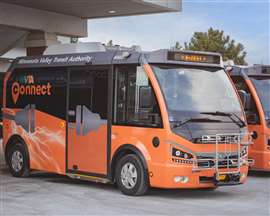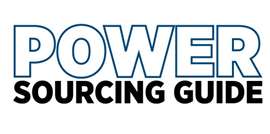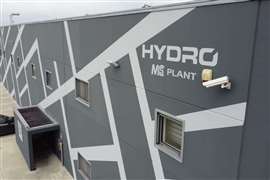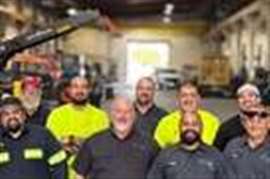Read this article in Français Deutsch Italiano Português Español
Minnesota transit agency decarbonizes microtransit program with BE buses
10 February 2025
In early December, the Minnesota Valley Transit Authority (MVTA) celebrated the launch of five new battery-electric (BE) buses. Based in Burnsville, Minn., and serving several suburbs south of Minneapolis and St. Paul, MVTA said the new 19-ft. Karsan e-Jest buses — the first BE vehicles in its fleet — each seat up to 10 passengers and one wheelchair. Each bus also has a bicycle rack.
The buses have begun serving the agency’s MVTA Connect microtransit program, an on-demand rideshare service in which customers can book trips via a smartphone app. MVTA Connect offers service in much of the agency’s coverage area seven days per week between 6 a.m. and 9 p.m.
 One of the Minnesota Valley Transit Authority’s (MVTA) e-Jest electric buses. (Photo: MVTA)
One of the Minnesota Valley Transit Authority’s (MVTA) e-Jest electric buses. (Photo: MVTA)
“Karsan was selected due to the e-Jest size, performance and alignment with the agency’s and community’s needs for microtransit solutions,” said Richard Crawford, a spokesperson for MVTA. Each e-Jest has a 130-mile range and can be fully charged in four hours, MVTA said. Regenerative braking contributes to recharging, as well.
MVTA has installed BE charging infrastructure at multiple sites and will continue to do so.
While Karsan is a Turkish bus maker, the OEM’s operations have expanded to North America, ensuring local production and support for MVTA’s fleet, the agency said. MVTA sourced the e-Jest vehicles from Karsan’s North American distributor Damera, which has facilities in Mississauga, Ontario, Canada, and Kissimmee, Fl, in the United States.
MVTA said selection of the e-Jest began in part with a 2023 demonstration project. In a March 2023 press release, Damera said the demo took place in Eagan, Minn., as part of MVTA Connect.
Operators who drove the e-Jest cited several benefits, including the panoramic windshield, built-in onboard LED lighting and turning radius, MVTA said. Passengers noted the vehicle’s smooth and quiet ride, adding that the grab bars were easy to reach and boarding was easy.
MVTA said that the e-Jest buses also proved capable of handling Minnesota’s winter weather, driving well despite wet driving surfaces. In the Damera press release, an MVTA representative said, “It stuck to the road like glue. We were very impressed about how well it handled in snow.”
During the demonstration project, the top speed for each e-Jest was about 45 mph. Scott Poppenhagen, fleet manager for MVTA, said that speed has since been improved, with each bus capable of reaching 65 mph.
The vehicles are also expected to save fuel for the agency. According to Poppenhagen, annual fuel savings from e-Jest electric vehicles will cover infrastructure costs within 3.5 years.
Sustainability was key in investing in BE buses.
“Reducing the carbon generated by our own operations is at the forefront of our sustainability plan, and we’re committed to being an industry leader on this front,” said Luther Wynder, CEO for MVTA.
MVTA said that each e-Jest bus will contribute to reduced carbon emissions on the order of 50 metric tons per year versus an internal combustion engine (ICE)-powered vehicle. U.S. Environmental Protection Agency (EPA) estimates indicate using an e-Jest instead of an ICE-powered vehicle is equivalent to removing 11 automobiles from the road, MVTA said.
The agency said its sustainability plan, adopted in 2023, highlights three key sustainability priorities: environmental, social, and economic value. One objective is eliminating greenhouse gas (GHG) emissions by 2050. MVTA also has a zero-emission bus (ZEB) plan, which Crawford said was developed concurrently with the sustainability plan.
The agency said the ZEB plan serves as its roadmap for transitioning to a zero-emission fleet of BE buses, and as both plans are considered ‘living documents,’ they will be updated as needed.
According to the plan, the full fleet transition to zero-emission buses is targeted for 2035. Vehicle acquisition was set to begin in 2026, but the agency is ahead of schedule with the adoption of the e-Jest buses.
This timeline aligns with the Minnesota legislature’s 2024 Transportation Omnibus Bill, which mandates 100 percent zero-emission buses by 2035, MVTA said.
Crawford added that the existing BE technology can serve about 70 percent of MVTA’s current routes, with battery advancements expected to support a full transition by 2032.
Poppenhagen said that MVTA’s e-Jest buses join others in operation across the U.S. “In the United States, there are currently about 40 e-Jest buses in service. They are in California, Massachusetts, North Carolina, Virginia and now Minnesota.”
An April 2024 Damera press release said that the Nantucket (Mass.) Regional Transit Authority (NRTA) has five e-Jest buses in its fleet. A Karsan press release in September said it delivered 14 e-Jest buses to Santa Maria Regional Transit in California.
POWER SOURCING GUIDE
The trusted reference and buyer’s guide for 83 years
The original “desktop search engine,” guiding nearly 10,000 users in more than 90 countries it is the primary reference for specifications and details on all the components that go into engine systems.
Visit Now
STAY CONNECTED




Receive the information you need when you need it through our world-leading magazines, newsletters and daily briefings.
CONNECT WITH THE TEAM













